Department of Chemistry History
Before establishing:
1811 - Chemistry lectures were given three times a week in the Pittsburgh Academy, the forerunner of the present University of Pittsburgh.
1819 - The Western University of Pennsylvania was chartered as the successor to the Pittsburgh Academy
1820 - Reverend Robert Bruce, the first "Principal" of the new University, began to teach chemistry, along with mathematics and philosophy.

1875
The department is first recognized at the Western University of Pennsylvania, forerunner to Pitt, with the appointment of Francis Clifford Phillips as professor of chemistry, geology and mineralogy. Phillips would serve as head of the department until 1915. He comments to Chancellor George Woods that the "complete lack of equipment is a serious obstacle." Woods quotes Sir Humphrey Davy as having publicly declared that "chemistry needs only a few tobacco pipes and teacups in order to perform the most varied experiments."
1892 - Professor Phillips writes to Chancellor W.J. Holland recommending that women be admitted to the chemistry laboratory. The next year, Maria Sophia Lynn is admitted to laboratory instruction. Women will be admitted to Western Pennsylvania University on a co-educational basis in 1895.
1903 - On February 3, 18 chemists meet to form the Pittsburgh Section of the American Chemical Society. Notable among these participants are Professor Phillips and a student, Alexander Silverman a future Dean of the School of Chemistry.
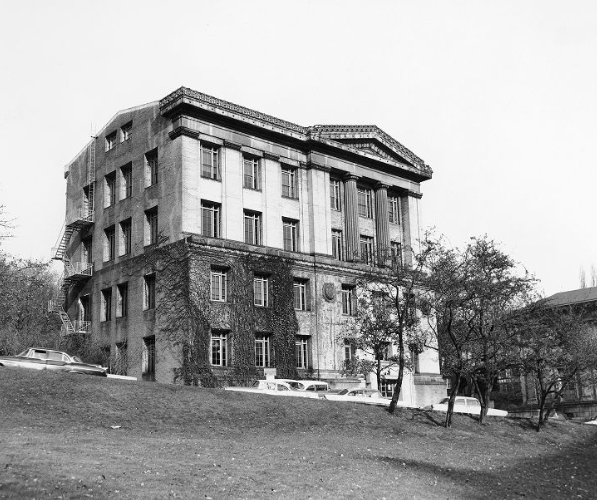
1905 - 1909 - The University changed its name to the University of Pittsburgh, and it moved from the North Side to Oakland. The Department first occupied quarters in the basement of State Hall and then moved to the third floor of Thaw Hall where it remained during the rest of Phillips's administration.
1905 - Alexander Silverman joins the Department's faculty. He will become a recognized international authority on the chemistry of glass.
1908 - The Graduate School of the University was established. Initially five departments, including Chemistry, offered doctoral courses, and ten departments, including these five, offered master's courses. Graduate programs and degrees were administered by the graduate school and the graduate council.
1909 - Dr. Charles Clarence Vogt joins as an assistant professor of inorganic and physical chemistry.
1913 - The Department of Chemistry awards its first Ph.D. to Hugh Clark. Also, that year, Mellon Institute was founded with strong ties to Pitt's chemistry department.
1914 - Department of Industrial Research (the academic part of Mellon Institute) granted four Ph.D.s in chemistry.
The first Ph.D. in chemistry, other than through the Mellon Institute, was awarded to Roy H. Uhlinger.
1915 – June: Professor Phillips retires from active service in the University. At a special dinner, alumni give him a check for $1,000: the Carnegie Foundation provides a pension equal to half of his salary.
September 1915 - In "the most important development in the University's growth since the inauguration
of the School of Education and Economics," the School of Chemistry is created, with Raymond F. Bacon (Director of Mellon Institute), as Dean. Alexander Silverman is made the head of analytical, inorganic, and physical chemistry and Professor David S. Pratt is made the head of organic chemistry.
Raymond Foss Bacon, director of Mellon Institute, is named dean of Pitt's School of Chemistry, with two units under his charge: organic chemistry; and analytical, inorganic and physical chemistry.
1917 - The Xi Chapter of the honorary chemical society Phi Lambda Upsilon is established.

1918 - Professor Silverman becomes sole head of Chemistry. Alexander Lowy joins the department as assistant professor of organic chemistry. Nearly 50 students will do their doctoral research with him. He will become internationally recognized for his expertise of dyestuffs and intermediates, electroorganic chemistry and disabling chemicals. Lowy's text, A Textbook of Organic Chemistry, co-authored with Benjamin Harrow, will be used widely in American colleges and universities.
Gebhard Stegeman joins the faculty as an assistant professor of physical chemistry. Professor Stegeman's research focuses on thermochemistry.
1919 - The first Phillips Medal to a senior chemistry student is awarded to Robert B. Corey. Later as a professor at Cal Tech, Corey will collaborate with Linus Pauling to publish revolutionary papers describing the structure of polypeptide helices and pleated sheets, and to design the well-known three-dimensional CPK molecular models.
1920 - Ground is broken for Alumni Hall, home of the School of Chemistry. Later that year, the school is reconverted to a department. Professor Francis Clifford Phillips dies in Ben Avon, PA of influenza-pneumonia on February 16, just short of his 70th birthday.
Carl Engelder is appointed to the Department as an assistant professor of analytical chemistry. He will go on to be a member of the faculty for 37 years, recognized nationally by the wide adoption of his analytical chemistry texts, including Calculations of Quantitative Analysis. Who's Who will list him as the originator of semi-micro methods of instruction.
1925 - The General Chemistry laboratory is moved to a two-story frame structure (formerly army barracks) on Herron Hill in back of the new stadium. The following year, the elementary organic chemistry laboratory is also moved to that building.
1926 - Rachel Hoyle Kesler becomes the first woman to be awarded a Ph.D. in chemistry at Pitt. Her dissertation, directed by Professor Lowy, is titled Derivatives of a Hydroxy-P-Naphthoic Acid.
1931 - Pitt chemistry professor Charles Glen King isolates and identifies Vitamin C in his laboratory in Thaw Hall.
At the same time, his teaching schedule is 23 hours per week, in five different kinds of courses, including two seminars, inorganic, industrial, food, and sanitary and biological chemistry. He will leave the Department in 1942 to become the scientific director of the Nutrition Foundation, but will still maintain strong ties to the Department and the University.
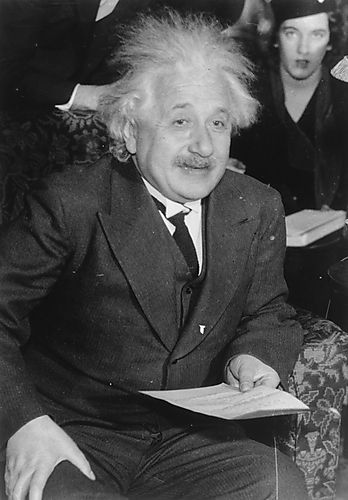
1934 - Dr. Albert Einstein discusses Atomic Theory at the 1934 American Association for the Advancement of Science (AAAS) meeting which was held at the University of Pittsburgh between December 27 and January 2, 1935. Reporters can be seen taking notes in the background. This meeting marked Einstein's first appearance at a U.S. scientific association.
1936 - Fire destroys the hilltop chemistry labs, causing $80,000 worth of damage. The labs are re-opened in the Dental Annex Building on O'Hara Street (now the Recreation and Wellness Center).
The Buhl Foundation makes the first of a series of grants in support of research to the Department that carry through the next 15 years.
1937 - Working his way through graduate school as a Pitt custodian, Edward Lee Harris earns a Ph.D. in chemistry. He is thought to be the first African American to earn the degree. Harris will go on to distinguish himself as faculty member and chair at Wilberforce College and as a rocket fuels consultant to Wright-Patterson Air Force Base.
It is announced that Alumni Hall, vacant since the move of classes to the Cathedral, would be remodeled and that all chemistry labs and offices would then be located there. The work to remodel Alumni Hall begins in 1937 and by 1941, the entire department is housed there.
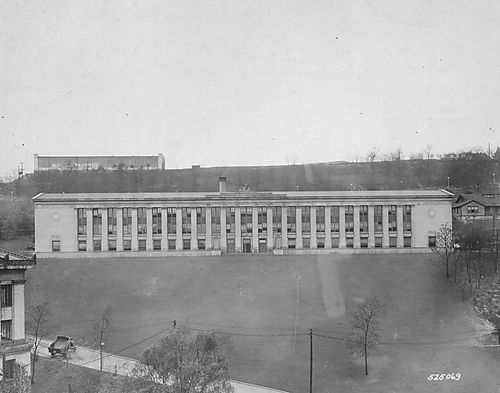
1940 - Students help in the move of the freshman teaching labs from the Old Dental Annex to Alumni Hall; the organic labs move in 1941.
1941 - Chemistry faculty begin teaching courses for the Engineering, Science and Management Defense Training program. Classes include Chemicals in Warfare, Chemical Analysis of Metallurgical Materials, Industrial Microscopy, Food and Water Inspection, and Chemical Fundamentals for War Workers.
Professor W.E. Wallace moves into the first completed research lab in Alumni Hall.
Professor Mary Warga from Physics conducts spectroscopic analysis to assist Chemistry's Max Schultz in his study of the role of copper in animal nutrition. In the 1990s, a graduate fellowship for women bearing Dr. Warga's name will be established in both disciplines.
March 1942 - In response to the war effort "Dean Crawford requests that the principles of explosives be incorporated into all chemistry courses."
September 1942 - Chemistry's first war contract is received. Details are strictly confidential.
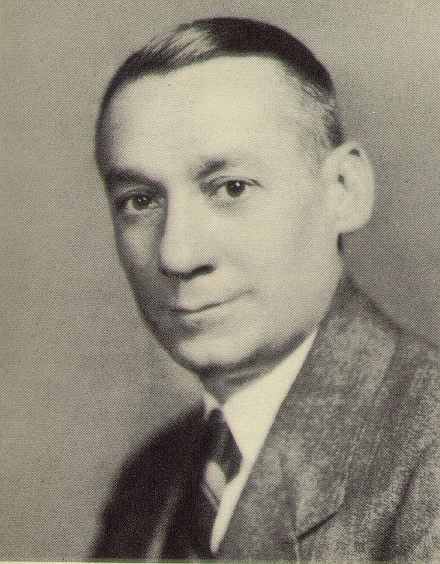
1944 - Professor Kendall Tesh, a well-liked member of the faculty since 1924, dies at his desk in the Chemistry Department while preparing to give an exam.
Professor Klaus Hofmann joins the chemistry faculty. During his career at Pitt he will make major contributions to organic and biochemistry from contributing to the understanding of the biological activity of biotin to synthesizing ACTH.
The Division of Research in the Natural Sciences was established, with Herbert E. Longenecker, Professor of Biochemistry, as Dean, to secure research funding, to integrate research activities in biology, chemistry, and physics and other departments, and to provide for their proper relationship with the College and the Graduate School. The primary donor (beginning even earlier) was the Buhl Foundation, and additional funds were provided by other foundations, industry, and some governmental agencies. In 1946 Longenecker also became
Dean of the Graduate School.
1949 - Professor Robert Levine publishes his discovery of the important reagent lithium diisopropyl amide (LOA), widely used in organic synthesis.
1950 - The first Pittsburgh Conference meeting is being held in the William Penn Hotel.
1951 - After more than 35 years in leadership capacity for the Department, Professor Alexander Silverman retires as Head. Professor Henry Sorg Frank is named as his replacement.
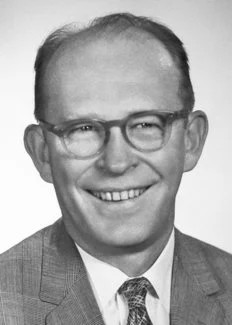
1955 - The Francis Clifford Phillips Lecture Series is established.
The Phillips Lecture Series is established, and Willard F. Libby gives the first lecture.
Libby will receive the Nobel Prize for Chemistry in 1960 for developing radiocarbon dating.
1956 - The Division of Research in the Natural Sciences gave way to a new organizational structure in the University. Three divisions were created within the academic disciplines, and the Chemistry Department became part of the Division of Natural Sciences, the others being the Division of the Humanities and the Division of the Social Sciences. The College of Liberal Arts became the undergraduate degree-granting unit for all three divisions. The graduate faculty within each division approved graduate programs and administered graduate degrees.
1959 - The world's most powerful permanent magnetic material, samarium cobalt (SmC05), is developed by Professor W. Edward Wallace.
1963 - Construction of the Space Research Coordination Center is completed in 1963. The new center will house the chemistry department's crystallography unit, which becomes a separate department under the Chairmanship of Professor George Jeffrey.
1967 - To ease the space crunch, three house trailers are placed on the hillside above the driveway of Alumni Hall to house office space for several faculty and all first-year teaching assistants.
1968 - The three divisions were merged into the Faculty of Arts and Sciences. The undergraduate degree-granting entity was renamed the College of Arts and Sciences. Graduate programs and degrees were administered by the graduate faculty of the Faculty of Arts and Sciences, with university-wide coordination provided by the University Council on Graduate Studies.
1969 - The Department receives a five year, $2.012 million grant from the National Science Foundation. The grant enables the Department to expand the faculty and staff and to acquire many new instruments and facilities.
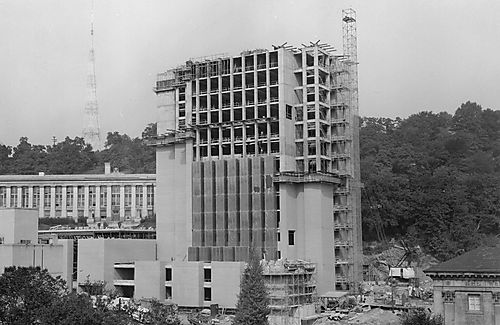
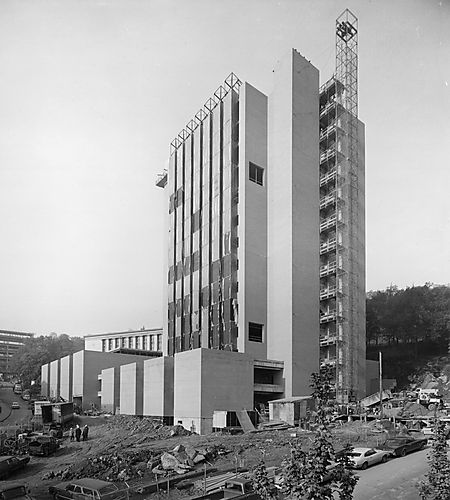
Under the codirection of Richard Howe of the Chemistry Department and Allegheny County Crime Laboratory and Charles Mcinerney, the Masters Degree Program in Forensic Chemistry is established at Pitt.
1971 - The Department is spread out all over campus: labs, classrooms, and offices are scattered among Alumni Hall, Clapp Hall, Langley Hall, Crawford Hall, Mellon Institute, Allen Hall, Old Engineering, the Cathedral, and the trailer complex on the hillside. In May, ground is broken for a new chemistry building.
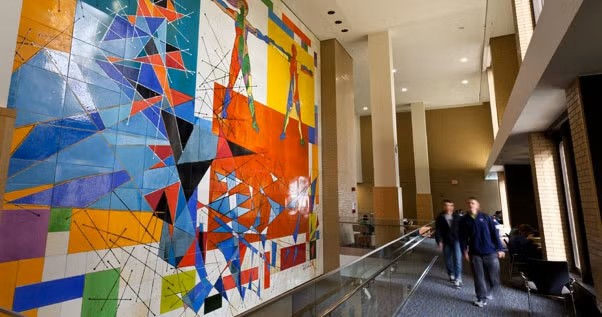
1974 - The new home of the chemistry department is completed in November of 1974, and is later renamed the Chevron Science Center. The auditorium complex is named for Lauren Ashe (BS, 1914) who, with his wife, establishes the Ashe Memorial Fund.
Artist Virgil Cantini installs the work he is the most proud of, his 1973 work, “Science and Mankind,” a 40 by 30 foot porcelain enamel mural inside the Chevron Science Center, depicting a man and a woman touching hands, their skeletal and muscular systems exposed. The colors used on the figures represent different human cells, and the squares and triangles around them symbolize the birth of the computer age.
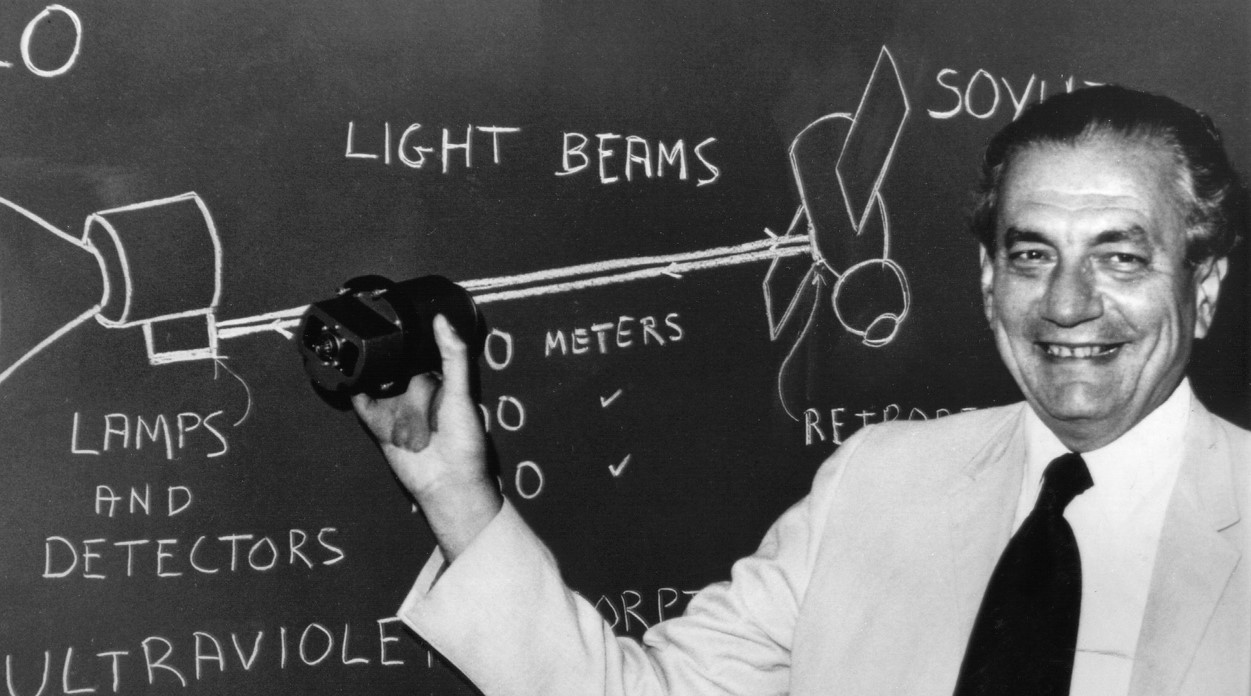
1977 - Professor Frederick Kaufman becomes Chair.
1979 – Mobay Lectures begin. In 1987, on the 9th Annual lecture the series is renamed the Bayer lectures. Then in 2015, it was renamed the Covestro Annual Lectures.
1980 - Professor Frederick Kaufman becomes the first Chemistry faculty member in residence to be elected to the National Academy of Sciences.
Professor David Hercules becomes Chair.
1984 - The Surface Science Center is dedicated with Professor John T. Yates, Jr. as its Director.
1985 - Hurd W. Safford Awards for Graduate Teaching Excellence are established in honor of Professor Safford's 44-year contribution to undergraduate chemistry.
On July 6, 1985, Professor Frederick Kaufman passed away.
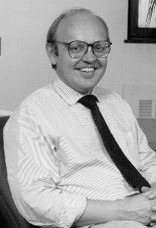
1987 – Frederick Kaufman Memorial Lectures are established.
1989 - Professor N. John Cooper becomes Chair.
1990 – Retired Professor Henry S. Frank passed away. He worked at the University for 12 years, ending in 1974. Professor Frank’s research had a huge impact in the theory of liquids and hydrogen bonding. His work on entropy paved the way to realization of the importance of hydrophobicity in chemistry and biology.
1994 - Professor Andrew Hamilton becomes Chair.
1996 – Professor Paul Dowd passed away on November 21st 1996.
1997 - Professor Craig Wilcox becomes Chair.
During his time as Chair, Professor Wilcox founded the Industrial Visitors Board (now discontinued). In this period the Department also established a Graduate Student Advisory Board to improve communications between department leaders and the graduate student body.
The Annual Dowd Memorial Lectures are established
1998 - The department awards its 1,000th Ph.D. in chemistry to Edward Wovchko.
The Combinatorial Chemistry Center is established with Professor Peter Wipf as its director.
In the Fall of 1998, the building then called Alumni Hall, which for many years housed the Computer Science Department, the Chemistry Library, and the Chemistry department’s Surface Science Center, was renamed Eberly Hall in recognition of the Eberly family's long-term support of the University. A gift from the Eberly Family Foundation was used in conjunction with state funds for major renovations of Eberly Hall. At the same time the Chemistry Library was moved to Chevron, and the Computer Science Department moved out to their new home in Sennott Square. These renovations provided much needed modern space for the Surface Science Center, the CMMS and contiguous space for the computational chemistry groups, and new physical chemistry and nanoscience groups.
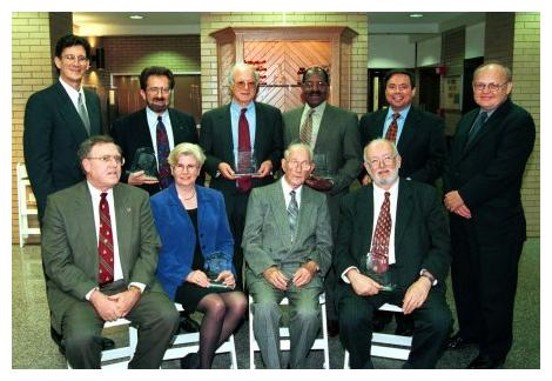
2000 - The Center for Molecular and Materials Simulations is established with Professor Kenneth Jordan as its Director.
With a gift from PPG, in 2000 the department established the PPG Materials Characterization Lab and renovated space for the new shared facility in Chevron. In the same year, with support from the Dean’s office and University leadership, the department laid out a successful multi-year vision for major renovations of research laboratories in Chevron. The last of these renovations are only now (2025) being completed. To kick off this project Dr. Wilcox chaired the group developing plans for a complete demolition and rebuilding of the 14th floor of Chevron Science Center (a plan the became the template for later renovations of many more synthetic organic chemistry labs in Chevron).
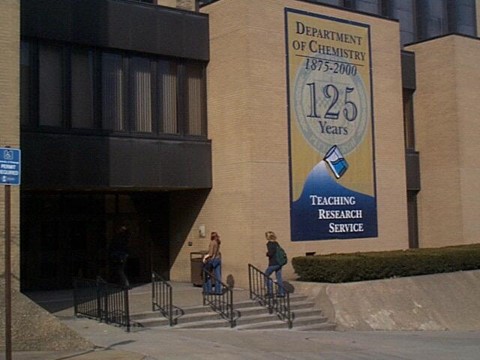
To celebrate the Department’s 125th anniversary, Professor Wilcox initiated the Department’s Distinguished Alumni Awards program (still active). The first event was held on Sept. 15th 2000 and honored 7 Alumni, Margaret Cavanaugh (BS, 1961), Paul Lauterbur (PhD, 1962), Alfred L. Moyé (PhD, 1968), Allen Roses (BS, 1963), David Rossi (BS, 1979), Michael Strem (PhD, 1964), W. Edward Wallace (PhD, 1942).
2002 – Professor Ken Jordan becomes Chair.
2003 – Former Alumni Awardee, Paul C. Lauterbur (Graduate Alumni, PhD 1962) wins the Noble Prize. The Nobel Prize in Physiology or Medicine 2003 was awarded jointly to Paul C. Lauterbur and Sir Peter Mansfield "for their discoveries concerning magnetic resonance imaging”
The department secured a $500,000 grant from NIH (Joe Grabowski, PI) for new mass spectrometry instrumentation in support of an ongoing research program. With this funding the facility added two new instruments: a Waters QTOF LC-MS (API hybrid quadrupole time-of-flight mass spectrometer with electrospray and APCI ion sources) and a Waters GCT GC-MS instrument (time-of-flight mass spectrometer with EI & CI sources). The mass spectrometry facility was moved back to Eberly Hall.
2005 – Professor David Waldeck becomes Chair.
2006 – During the Spring of 2006, Department Chair David Waldeck sent letter to our many friends and supporter to request their assistance in raising fund for our Undergraduate Analytical Laboratory. Many supporters generously donated which allowed us to purchase 3 new gas chromatographs and 6 new UV-Spectrophotometers to be used by our undergraduate students.
2007 – Professor Ken Jordan becomes a Distinguished Professor of Computational Chemistry.
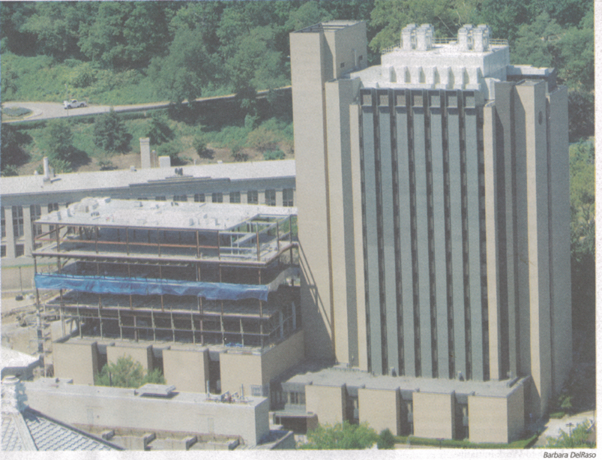
Henry S. Frank Lectures are established with Professor David Wales, University of Cambridge as the first speaker for this annual series.
2009 – University approved the construction of a new three-story annex to be built over the Ashe auditorium complex. This facility would provide excellent new space for synthesis, helping expand our effort in natural products and material synthesis.
2010 – Johannes F. Coetzee Memorial Fund is used to endow a lectureship in Johannes’ memory (Still active).
2011 – The Chevron Annex is completed! The renovation included lecture halls, synthetic chemistry research department offices, a 30-person computer classroom, new student study and lounge space, a café (Bunsen Brewer), renovated main entry lobby to the chemistry department and support, and synthetic chemistry labs.
2014 – Professor Kay Brummond becomes Chair. She is the first woman to become chair!
Kenneth Jordan was named Richard King Mellon Professor. Jordan was honored in a special issue of J. Phys. Chem. A, “From Quantum Mechanics to Molecular Mechanics: A Tribute to Kenneth D. Jordan” as a leader in the field of theoretical chemistry on the occasion of his 66th birthday!
2015 – Chemistry Department announced a new program, summer undergraduate research fellowship at Pitt, SURF Pitt. For Female or underrepresent minority (URM) undergraduate students from other universities. The purposes of this program were to promote chemistry as their career for female and URM students to further improve our diversity in our research program.
May 2015 – Pitt Chemistry Stockroom (PCS) & the Biological Sciences Stockroom (BSS) were reorganized to form the Dietrich Stockroom (DSS).
2017 – Professor Sunil Saxena becomes Chair.
2020 – University of Pittsburgh must face the challenges of COVID-19. When the shutdowns began in March 2020, Pitt undergraduates’ students were away on Spring break. The University delayed the restart of classes, which gave Chemistry Faculty two weeks to transition their courses to an online format. The new paradigm would persist for an additional year during which faculty creatively tackled the challenge of communicating abstract chemical concepts via Zoom or in socially distanced classrooms.
2023 – Professor Haitao Liu becomes Chair.
Graduate Administrator, Christie Hay, hosts the first Annual Career & Networking Fair (still active).
2025 – 150th Anniversary of the Department of Chemistry! It will be celebrated with a department wide event with a poster session, speaker & demonstration on this year’s Homecoming weekend. See Event Details.
